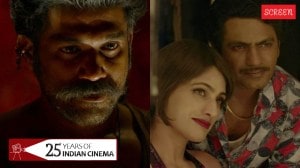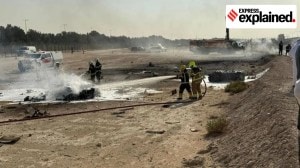A journey to the end of the earth
Portuguese filmmaker Gonçalo Tochas new film Its the Earth Not the Moon explores the island of Corvo in Portugal
Mike Hale
The Portuguese filmmaker Goncalo Tochas Its the Earth Not the Moon begins on the ocean,with nothing visible but water,the prow of a boat and,in the distance,the hazy outline of what might be an island. The boat is carrying Tocha to Corvo,the farthest and smallest outcropping of the Azores archipelago,in the mid-Atlantic more than 900 miles from the Portuguese mainland.
Its an extraordinary island, the boats captain says. I am not going to tell you how it is but Azores,its crazy. And there,its even crazier.
For the next three hours the film immerses the viewer in that tiny (7 square miles) place,home to a hardy population of fewer than 500. Never leaving the island,except for the occasional fishing trip,Tocha tries to show us everything there is to see and do,and all there is to know about Corvo,which he calls the endafter that you cannot go anywhere else.
Corvo is a place where premodern rituals of harvest and slaughter sit side by side with disco balls and a contentious,media-saturated local election. Old men who still herd cattle near sheer 2,000-foot cliffs.
I call it a travel adventure film, Tocha said. Its like the book of an explorer who goes to a place and makes a journal or diary of discovering.
There is a literary quality to Its the Earth emphasised by its division into numbered chaptersas well as an ethnographic impulse that can make it feel antique. But it also feels completely modern,making itself up as it goes along.
Said Tocha,33,I was trying to really film everything I could. The kind of film it will be I didnt have any clue. Every year I went to the Azores,it was this childhood dream of the nature and the ocean.
Its the Earth shows the islands absurdly dramatic landscape from every vantage point: atop its cliffs,across its small and verdant pastures,inside the gently eerie caldera of an extinct volcano.
It was more of a challenge to portray the inhabitants,residents of a neat little port that dates to the 16th century. It helped that Tochas entire crew during two years of filming consisted of him and his sound man,Didio Pestana. They (the people) are suspicious of what the image can do. Theyre very proud. Nobody knew us,so we have to live there,they have to trust us.
One set of recurring images thats puzzling for the viewer,presented in verite style without explanation,shows anonymous people dancing,somewhat listlessly,in strobe-lighted sessions at a bar. They are in the film,Tocha said,because it was the islands young people who were most resistant to appearing.
The new generation is very conscious of the images, he said,explaining that this was the only way they would agree to be in the film. He added,Actually I liked thatthey are the generation that doesnt speak,and in 20 years they will be running Corvo.
Long a symbol of isolation,Corvo has changed radically as transportation has improved over the last 50 years,and the changes will only accelerate. Everything thats happening everywhere in Western society is happening in this island,but its happening for the first time, he said. Its a laboratory of human life.



- 01
- 02
- 03
- 04
- 05




























